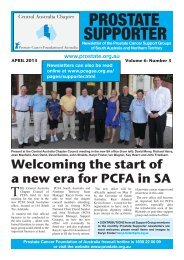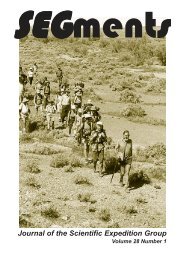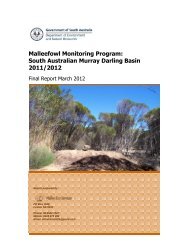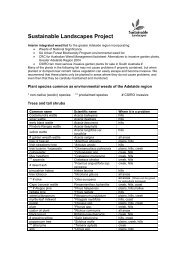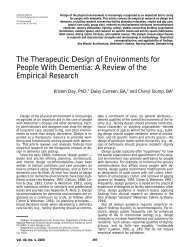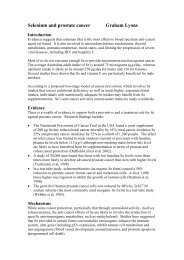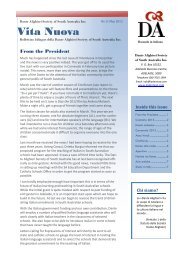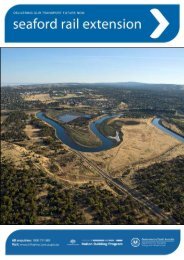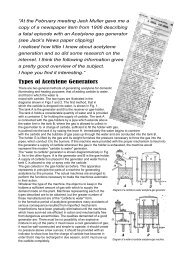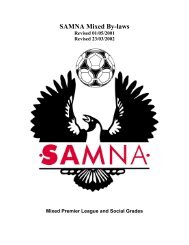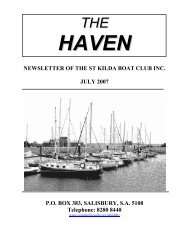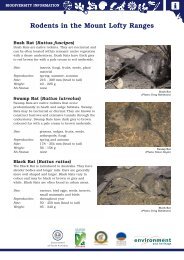Action Plan for Dry Creek Reserve - Communitywebs.org
Action Plan for Dry Creek Reserve - Communitywebs.org
Action Plan for Dry Creek Reserve - Communitywebs.org
Create successful ePaper yourself
Turn your PDF publications into a flip-book with our unique Google optimized e-Paper software.
<strong>Action</strong> <strong>Plan</strong> <strong>for</strong><br />
<strong>Dry</strong> <strong>Creek</strong> <strong>Reserve</strong><br />
(City of Port Adelaide Enfield)<br />
Valley View. SA<br />
2009 to 2015<br />
Page 1 of 16
<strong>Action</strong> <strong>Plan</strong> <strong>for</strong><br />
<strong>Dry</strong> <strong>Creek</strong> <strong>Reserve</strong>,<br />
(City of Port Adelaide Enfield)<br />
Valley View.<br />
Introduction<br />
This <strong>Action</strong> <strong>Plan</strong> has been written <strong>for</strong> the Friends of <strong>Dry</strong> <strong>Creek</strong> Trail Inc. to assist in the<br />
protection and maintenance of <strong>Dry</strong> <strong>Creek</strong> <strong>Reserve</strong>, a Catchment Care site, within the City<br />
of Port Adelaide Enfield.<br />
The Friends of <strong>Dry</strong> <strong>Creek</strong> Trail Inc. see this as an opportunity to be involved in the<br />
rehabilitation of the biodiversity of the region, and to display the beauty of the regions<br />
native species.<br />
This <strong>Action</strong> <strong>Plan</strong> describes the objectives, the site, and the influences that affect the site,<br />
and, who would be involved. It also details the volunteer program of activities, including<br />
planting, maintenance, weeding, and monitoring.<br />
Objectives<br />
<br />
<br />
<br />
<br />
To show what can be done in an urban situation,<br />
o re-create the remnant vegetation association,<br />
o re-create the habitat <strong>for</strong> birds and lizards as well as aquatic insects and<br />
animals,<br />
o restore the population abundance and richness of remnant species,<br />
To seek appropriate funds and resources, to carry out this plan,<br />
Look <strong>for</strong> opportunities to expand the groups activities,<br />
Offer a range of opportunities to the members of the Group, and the local<br />
community to develop their understanding and knowledge of the regions<br />
biodiversity.<br />
o This will be done by<br />
Projects,<br />
Workshops,<br />
Educational resources,<br />
Formal training.<br />
Page 2 of 16
Location<br />
<strong>Dry</strong> <strong>Creek</strong> <strong>Reserve</strong> Catchment Care site is bounded by Grand Junction Road, Haddington<br />
St, Ancell St and Down Dve Valley View.<br />
It is part of the <strong>Dry</strong> <strong>Creek</strong> <strong>Reserve</strong> under the control and maintenance of the City of Port<br />
Adelaide Enfield.<br />
General Site Description<br />
<strong>Dry</strong> <strong>Creek</strong> <strong>Reserve</strong> is representative of an open Red Gum (Eucalyptus camaldulensis)<br />
woodland, over small trees, shrubs and grasses. The upper canopy is Eucalyptus<br />
camaldulensis, over exotic and native grasses such as Themeda triandra, Poa species,<br />
Austrostipa species, and Austrodanthonia species. A mixture of riparian and terrestrial<br />
plants, including trees, shrubs and groundcovers, are found on the site. There has been<br />
supplementary plantings of some species, and natural recruitment of others. The location<br />
of those species depend on the existing drainage pattern. A list of known endemic species<br />
as well as exotic and Australian weed species is included in the appendices.<br />
The site has a riparian profile with <strong>Dry</strong> <strong>Creek</strong> flowing through it.<br />
The Catchment Care site is surrounded by urban residential and local service business<br />
development. The reserve is used by the local community and others <strong>for</strong> both active and<br />
passive recreation, mainly walkers and joggers.<br />
Page 3 of 16
Conservation Value.<br />
Vegetation Association.<br />
The <strong>Dry</strong> <strong>Creek</strong> catchment is part of a nationally threatened species and ecological<br />
community (EPBC Act Policy Statement 3.7) of Peppermint Box (Eucalyptus odorata)<br />
Grassy Woodland of South Australia and Iron-grass Natural Temperate Grassland of<br />
South Australia.<br />
Species significance.<br />
The Catchment Care site has no known species of national significance. Further<br />
identification work needs to be done to determine if there are any species of South<br />
Australian or regional significance.<br />
Comments.<br />
Any revegetation work and rehabilitation work needs to been done sensitively to ensure<br />
the site is restored to the desired association, either a riparian association or an open<br />
woodland - grassland association where appropriate. This will allow the ephemeral<br />
endemic species to return.<br />
Line-of-sight issues <strong>for</strong> path users, the risk of fire and other risk management issues needs<br />
to be considered in any work undertaken by the group. Advice from appropriate City of<br />
Port Adelaide Enfield, or Catchment Care officers will be sought and taken.<br />
Reference sites<br />
<strong>Dry</strong> <strong>Creek</strong> Linear Park, Walkley Heights has been recognised as an appropriate reference<br />
site. This reference site tells us what the <strong>Dry</strong> <strong>Creek</strong> <strong>Reserve</strong> should be like.<br />
Management Issues<br />
The management aim is to restore the Catchment Care site to its original open woodland /<br />
grassland association, weed free, and to promote its biodiversity value and beauty. Ef<strong>for</strong>ts<br />
to further restore the grassland lower strata will be the significant part of the approach to<br />
restore the biodiversity of the site. The upper storey species are relatively in tact so do not<br />
require supplementary plantings.<br />
Ef<strong>for</strong>ts to remove or reduce the impacts of past agricultural management practices, and<br />
current urban development issues needs to be introduced. This shall be done in<br />
consultation and with approval of the City of Port Adelaide Enfield, as it is the ‘landholder’<br />
of the site.<br />
Weeds<br />
Weed infestation are the major problem of the site. Exotic grasses, brought in under past<br />
management, out-compete endemic grasses <strong>for</strong> nutrients, space, light, and water.<br />
Weed control needs to be sensitive to the desired riparian or grassland species and their<br />
management, allowing natural growth and recruitment.<br />
Page 4 of 16
Adjoining Land Use.<br />
There is some impact due to the altered drainage patterns from urban development<br />
infrastructure that now occur.<br />
Trash, sediment, illegal dumping, garden and weed species infestation, and vandalism,<br />
are major concerns. Some fencing and defined paths do control the degree of some of the<br />
impacts. However little can be done to remove all impacts. Monitoring shall be carried out<br />
to identify the effects of impacts, and sensitive and appropriate actions will be carried out<br />
in response.<br />
Of interest are the properties just upstream of the site, where the title of the properties was<br />
made prior to the current system. This allows the owners of the property rights to the creek<br />
bed rather than the 1 in 100 year flood levels.<br />
Recreational Use.<br />
The Catchment Care site is next to the linear trail system found along <strong>Dry</strong> <strong>Creek</strong>. Walkers,<br />
joggers and bike riders often use this trail system. Trash, weed infestation, unintentional<br />
vandalism, and fire vandalism are impacts. Fences and <strong>for</strong>med paths control the impacts<br />
to some degree. Monitoring shall be carried out to identify the effects of impacts, and<br />
sensitive and appropriate actions will be carried out in response.<br />
Foxes, Dogs and Cats.<br />
These animals either hunt and eat, or, disturb and harass local birds and reptiles. State<br />
and Local Government controls are in place, but little can be done by the Friends of <strong>Dry</strong><br />
<strong>Creek</strong> Trail Inc. to remove these impacts. However education of the local community and<br />
monitoring shall be carried out to identify any effects of the impacts, and sensitive and<br />
appropriate actions will be carried out in response.<br />
Management <strong>Action</strong>s<br />
The actions below are considered necessary to achieve the group’s objectives. As stated<br />
be<strong>for</strong>e, it is to restore the Catchment Care site to its original open woodland / grassland<br />
association, weed free, and to promote its biodiversity value and beauty. It is also<br />
recognised that this can only be done with an active, knowledgeable and healthy<br />
community, with the support of the City of Port Adelaide Enfield and relevant Departments<br />
of the State Government.<br />
Site Management.<br />
The site is surrounded by housing development. Formed access paths run through it and<br />
along side it. Interpretative signage has been erected on the site. The care and<br />
maintenance of the paths, fences and signs are under the control of the City of Port<br />
Adelaide Enfield .<br />
Inspection of paths, fences and signs shall be carried out and reported to the City of Port<br />
Adelaide Enfield, where appropriate actions will be carried out in response.<br />
Monitoring<br />
Monitoring shall be carried out to identify and record any positive or degrading changes to<br />
the site. This will take the <strong>for</strong>m of a photopoint being established according to the Our<br />
Patch document “Using Photopoints”. Also, use of a workbook that has regular and<br />
Page 5 of 16
elevant notes made in it on changes observed in the site as well as species observed,<br />
and any actions taken.<br />
Photopoint.<br />
The method and location to establish the photopoint shall be modified to suit the site. It is<br />
important the method and location is well documented and repeat regularly.<br />
Work book.<br />
The workbook will be used to create and annual list of endemic species, with notes made<br />
on species location, species numbers, and species condition. It will also cover animal, bird<br />
and reptile species. Any other relevant observations will also be included.<br />
The workbook will be used to create and annual list of weed species, with notes made on<br />
species location, species numbers, and species condition. It will also include notes on<br />
weed control ef<strong>for</strong>ts and any other relevant observations that can be used to develop a<br />
yearly weed control action plan.<br />
Volunteers are encouraged to record entries in the workbook of their own observations<br />
and experiences whilst working in the general area.<br />
Weed Control.<br />
Exotic weeds have had a significant impact on the Catchment Care site and are a major<br />
issue that will require considerable attention <strong>for</strong> some time to come. However some good<br />
weed control work has already been done on some areas within the site<br />
A list of weeds is included as an appendix.<br />
Any weed control needs to be sensitive to the desired grassland species and their<br />
management, especially the lower strata, allowing <strong>for</strong> natural growth and recruitment.<br />
Fire caused by vandalism is a major concern of the City of Port Adelaide Enfield. And fire<br />
is a major concern <strong>for</strong> the committee as it can destroy and set back the ef<strong>for</strong>ts of the<br />
Friends. So the reduction of fuel load from weeds shall be a major priority in the Friends<br />
planning and actions.<br />
The Catchment Care site shall have a weed control map developed, where the<br />
distributions of the major weeds are zoned, and where there may be future invasion and<br />
establishment. A weed control plan shall be developed where these zones will be<br />
prioritised depending on the biodiversity or remnant plant value of the zone, the<br />
invasiveness of the weed, and the practicality of the control method. Kept in mind is the<br />
need to reduce fuel load from weed trash.<br />
The book “Stop Bushland Weeds, A guide to successful weeding in South Australia’s<br />
bushland”, 2 nd Edition, written by Meg Robertson, published by The Nature Conservation<br />
Society of South Australia Inc., shall be used to provide the principles, strategy and<br />
techniques to undertake weed control on the site.<br />
The <strong>for</strong>e mentioned book provides a “Look After The Bush” strategy, which the committee<br />
has amended slightly:-<br />
Primary Weeding. Begin weeding in the least weedy section, then wait and watch<br />
<strong>for</strong> weed or native seedlings to spread into the gap.<br />
Follow Up. Hand pull weed seedlings and any regrowth.<br />
Page 6 of 16
<strong>Plan</strong>ting with desired lower strata species.<br />
Maintenance. Monitor weeded sections regularly, working towards keeping it weed<br />
free.<br />
The book also provides a “Bushland Weeding Code”:-<br />
1. Look be<strong>for</strong>e you weed,<br />
2. Choose the most effective and selective weed control technique,<br />
3. Adapt to the season and the weather conditions,<br />
4. Minimise the amount of trampling that would occur when weeding,<br />
5. Look <strong>for</strong> the smaller weeds under the larger weeds as you control the larger weeds,<br />
6. Avoid damage to desire plants,<br />
7. Disturb the soil as little as possible,<br />
8. Remove any parts of the weed that will regrow or set seed,<br />
9. Do follow up weeding be<strong>for</strong>e moving to a new section,<br />
10. Sufficiently weed around desired plants to prevent them being shaded out, or outcompeted,<br />
11. Prevent weed seed, bulbs or runners being brought on to the site.<br />
Techniques to be used are:-<br />
Hand-pull,<br />
o <strong>for</strong> seedlings and other small, soft plants without reproductive bulbs,<br />
o <strong>for</strong> small woody plants such as olive seedlings,<br />
avoid soil disturbance and manual handling injuries.<br />
Hand-dig and grub,<br />
o <strong>for</strong> soft leafy plants with tap roots,<br />
o <strong>for</strong> plants with a growing point just at or below the ground,<br />
o <strong>for</strong> plants with a swollen root system,<br />
o <strong>for</strong> small to medium woody shrubs which may reshoot or it is undesirable to<br />
use herbicide,<br />
avoid soil disturbance and manual handling injuries.<br />
Slash or clip,<br />
• Use of power tools such as a whipper snipper will only be used by a trained<br />
operator,<br />
The operator shall use the Safe Operating Procedure provided by the<br />
City of Port Adelaide Enfield .<br />
o <strong>for</strong> annual species prior to seed set,<br />
o <strong>for</strong> dense stands of perennial weeds prior to seed set, or prior to use of<br />
herbicide,<br />
o <strong>for</strong> perennial plants to remove dead or old growth prior to use of herbicide.<br />
Herbicide <strong>for</strong> “soft” plants,<br />
<br />
• Only trained operators will apply herbicide,<br />
<br />
training is available through Catchment Care, Friends of Parks,<br />
registered training providers etc.<br />
o Spot spray <strong>for</strong> appropriate weeds,<br />
Shield desired plants,<br />
o Wipe on using a sponge, wick, weeding tongs etc, <strong>for</strong> appropriate weeds.<br />
Herbicide <strong>for</strong> “woody” weeds,<br />
• Herbicide use is not expected to be required at this stage. However its use<br />
may be warranted in limited situations. There<strong>for</strong>e only trained operators will<br />
apply herbicide,<br />
<br />
The operator shall use the Safe Operating Procedure provided by the<br />
City of Port Adelaide Enfield .<br />
Page 7 of 16
Training is available through Catchment Care, Friends of Parks, Trees<br />
For Life and registered training providers etc.<br />
o Drill and Fill,<br />
o Frill and swab,<br />
o Cut and swab,<br />
• Use of power tools such as a chainsaw <strong>for</strong> woody weeds is not expected to<br />
be required at this stage. However its use may be warranted it limited<br />
situations. There<strong>for</strong>e only trained operators will use chainsaws,<br />
The operator shall use the Safe Operating Procedure provided by the<br />
City of Port Adelaide Enfield .<br />
Training is available through Catchment Care, Friends of Parks, Trees<br />
For Life and registered training providers etc.<br />
Disposal of weeds, trash and other debris shall be removed from the site to prevent weed<br />
invasion, fire vandalism, and soil disturbance. Large quantities may be taken away on<br />
request to the City of Port Adelaide Enfield. However, if possible, the weeds, trash and<br />
other debris will be bagged <strong>for</strong> removal by the City of Port Adelaide Enfield. The bags will<br />
not be filled to more than 20 kilograms per bag to prevent manual handling issues <strong>for</strong> the<br />
City of Port Adelaide Enfield workers.<br />
A range of weed control handouts developed <strong>for</strong> the National Trust is also included in the<br />
appendices. These handouts illustrate the concepts that are further developed in the “Stop<br />
Bushland Weeds” book.<br />
<strong>Plan</strong>ting.<br />
Two of the objectives of the group are to show what can be done in an urban situation,<br />
and, to offer a range of opportunities to the members of the Group to develop their skills<br />
and knowledge of the regions biodiversity. To meet those objectives, planting days have<br />
been set aside to help restore the Catchment Care site.<br />
The plants used will be endemic species of the site, preferably grown by the members of<br />
the group, from seed collected in the area. Appropriate City of Port Adelaide Enfield<br />
permission and Department of Environment and Heritage Permits will be obtained prior to<br />
seed being collected.<br />
However, if the members of the group are unable to grow the plants required <strong>for</strong> planting,<br />
then alternate growers and any required funding shall be sought from either the City of<br />
Port Adelaide Enfield, the Catchment Care program, the Natural Resource Management<br />
Board, the Urban Biodiversity Unit of the Department of Environment and Heritage, or any<br />
other body that will support the objectives of the group.<br />
To improve the biodiversity of the site, the plantings will rein<strong>for</strong>ce the population<br />
abundance and richness of remnant species existing on the site, especially the lower<br />
strata. Species selection will be determined by the group after consulting the appropriate<br />
officers of the City of Port Adelaide Enfield and Catchment Care.<br />
The planting positions are to be determined in line with the Friends “Look After The Bush”<br />
strategy, after consulting the appropriate officers of the City of Port Adelaide Enfield and<br />
the Catchment Care program.<br />
A planting plan will be developed using a staged strategy that divides the site into sections.<br />
Each section will undergo a process of Woody Weed Control, then Perennial Weed<br />
Page 8 of 16
Control – Tree/Shrub <strong>Plan</strong>tings, followed by Perennial <strong>Plan</strong>tings, and finally Site<br />
Maintenance.<br />
Woody Weed Control.<br />
Trees and woody shrubs will be selected <strong>for</strong> removal either in the year assigned, or<br />
after the replacement plantings have grown sufficiently to minimise community<br />
response.<br />
The trees and shrubs are selected as they are not endemic species grown and do<br />
not con<strong>for</strong>m to the endemic association.<br />
Approval from the City of Port Adelaide Enfield is required prior to the removal of<br />
any vegetation.<br />
Perennial Weed Control – Tree/Shrub <strong>Plan</strong>tings.<br />
Appropriate weed control shall be undertaken to remove perennial weeds prior to<br />
plantings of trees and shrubs.<br />
Approval from the City of Port Adelaide Enfield is required prior to any weed control.<br />
o The City of Port Adelaide Enfield will determine who is responsible <strong>for</strong> weed<br />
control.<br />
Tree and shrub planting will be carried out to replace vegetation that has been<br />
removed.<br />
Replacement planting and infill <strong>for</strong> lost plants will continue in the following years.<br />
Perennial <strong>Plan</strong>tings.<br />
To further improve the biodiversity value of the works, understory and other aquatic<br />
plants will be planted.<br />
Replacement planting and infill <strong>for</strong> lost plants will continue in the following years.<br />
Site Maintenance.<br />
This will take the <strong>for</strong>m of weed control<br />
Replacement planting and infill <strong>for</strong> lost plants will continue in the following years.<br />
Maintenance will continue on all zones during the year. But it is hoped that<br />
maintenance will reduce in the following years.<br />
Page 9 of 16
Page 10 of 16
Volunteer Development.<br />
The committee see’s that the group needs to broaden the experience and understanding<br />
of its members so they can value and recognise the beauty of the region’s biodiversity.<br />
This will in turn repay the ef<strong>for</strong>ts of the members which will then hopefully mean the<br />
members will remain involved and enthusiastic.<br />
The committee sees the need to source training and in<strong>for</strong>mation <strong>for</strong> the members in:-<br />
<strong>Plan</strong>t and Animal knowledge and understanding.<br />
Understanding of the area’s biodiversity and how Kingfisher <strong>Reserve</strong> fits into the<br />
regions context.<br />
Obtain training in Bushcare techniques.<br />
Obtain training in Weed and Pest control.<br />
Involve the members in Waterwatch, frog, bird, reptile, and bat census to further<br />
develop the understanding of the regions biodiversity.<br />
Tours of other sites to develop the Friends appreciation of the regions biodiversity.<br />
The group will register with the City of Port Adelaide Enfield and the Natural Resource<br />
Management Board to obtain volunteer support, volunteer development, and training.<br />
Volunteer Management.<br />
The management committee of the Friends of <strong>Dry</strong> <strong>Creek</strong> Trail Inc. will manage the group.<br />
Its purpose will be to meet the needs of the volunteers, by recognising the skills and<br />
wishes of the volunteers, then to match those skills and wishes to activities and<br />
opportunities that the group can provide.<br />
The group shall use the “In Safe Hands” toolkit developed by Conservation Volunteers<br />
Australia to manage the risks and safety of the members. The committee will implement an<br />
Occupational Health and Safety policy, Implementation Guidelines, Safety Prompts,<br />
Volunteer Induction guide, Project Briefing Guide, Volunteer Safety card, and other record<br />
keeping documents as provided by the “In Safe Hands” toolkit.<br />
The group will register with the City of Port Adelaide Enfield and the Natural Resource<br />
Management Board to obtain volunteer support and insurance. Support sought includes<br />
the provision of advice and direction in conservation matters, safety and volunteer<br />
management procedures, as well as materials and resources.<br />
The committee will seek funding to purchase any appropriate equipment required to safely<br />
carry out its activities. This includes an outdoor first aid kit suited to conservation groups<br />
using hand held tools and power tools. It will also purchase a suitable drinking water<br />
container and sufficient drinking cups.<br />
The committee will endeavour to communicate all its activities to the local community<br />
surrounding the site, as well as to the broader community through the City of Port Adelaide<br />
Enfield. The intention is to gain support <strong>for</strong> the group’s activities and to broaden the<br />
community’s understanding of biodiversity and conservation issues<br />
Page 11 of 16
Native Species List<br />
Name<br />
common name<br />
Acacia paradoxa kangaroo thorn<br />
Acacia pycnantha golden wattle<br />
Acacia salicina Port Broughton Willow<br />
Acacia acinacea wreath wattle<br />
Arthropodium strictum common vanilla lily<br />
Atriplex sp. saltbush<br />
Austrodanthonia sp.<br />
Austrodanthonia racemosa sp. racemosa wallaby grass<br />
Austrodanthonia caespitosa<br />
common wallaby grass<br />
Austrostipa nitida spear grass<br />
Austrostipa nodosa tall spear grass<br />
Austrostipa scabra ssp. Falcata slender spear grass<br />
Austrostipa sp.<br />
Bursaria spinosa sweet bursaria<br />
Calystegia sepium<br />
Carex breviculmis short stem sedge<br />
Chloris truncata windmill grass<br />
Convolvulus remotus grassy bindweed<br />
Cyperus vaginatus stiff flat sedge<br />
Dianella revoluta ssp. revoluta black anther flax lily<br />
Dodonaea viscosa ssp. spatulata sticky hop bush<br />
Eucalyptus camaldulensis river red gum<br />
Lomandra nana small mat rush<br />
Oxalis<br />
perennans<br />
Pittosporum phylliraeoides var. microcarpa native apricot<br />
Themeda triandra kangaroo grass<br />
Vittadina sp. new holland daisy<br />
Page 12 of 16
<strong>Action</strong> Schedule<br />
The following table suggests a possible action schedule. It may be adjusted each year and<br />
through the year due to seasonal factors and work already undertaken.<br />
Year<br />
Woody Weed<br />
Control<br />
Perennial Weed<br />
Control-<br />
Tree Shrub<br />
<strong>Plan</strong>tings<br />
Perennial<br />
<strong>Plan</strong>tings<br />
Site<br />
Maintenance<br />
2009 Zone 1<br />
2010 Zone 2 Zone 1<br />
2011 Zone 3 Zone 2 Zone 1<br />
2012 Zone 4 Zone 3 Zone 2 Zone 1<br />
2013 Zone 4 Zone 3 Zone 2<br />
2014 Zone 4 Zone 3<br />
2015 Zone 4<br />
Woody Weed Control.<br />
Trees and woody shrubs will be selected <strong>for</strong> removal either in the year assigned, or<br />
after the replacement plantings have grown sufficiently to minimise community<br />
response.<br />
The trees and shrubs are selected as they are not endemic species grown and do<br />
not con<strong>for</strong>m to the endemic association.<br />
Approval from the City of Port Adelaide Enfield is required prior to the removal of<br />
any vegetation.<br />
Perennial Weed Control – Tree/Shrub <strong>Plan</strong>tings.<br />
Appropriate weed control shall be undertaken to remove perennial weeds prior to<br />
plantings of trees and shrubs.<br />
Approval from the City of Port Adelaide Enfield is required prior to any weed control.<br />
o The City of Port Adelaide Enfield will determine who is responsible <strong>for</strong> weed<br />
control.<br />
Tree and shrub planting will be carried out to replace vegetation that has been<br />
removed.<br />
Replacement planting and infill <strong>for</strong> lost plants will continue in the following years.<br />
Perennial <strong>Plan</strong>tings.<br />
To further improve the biodiversity value of the works, understory and other aquatic<br />
plants will be planted.<br />
Replacement planting and infill <strong>for</strong> lost plants will continue in the following years.<br />
Site maintenance.<br />
This will take the <strong>for</strong>m of weed control<br />
Replacement planting and infill <strong>for</strong> lost plants will continue in the following years.<br />
Maintenance will continue on all zones during the year. But it is hoped that<br />
maintenance will reduce in the following years.<br />
Page 13 of 16
<strong>Plan</strong>t List<br />
The following table suggests a possible plant list. It may be adjusted each year and through the year due to seasonal factors, site issues<br />
and work already undertaken.<br />
Year Zone 1 Zone 2 Zone 3 Zone 4<br />
2009 100 Eucalyptus camaldulensis<br />
50 Acacia salicina<br />
50 Acacia pycnantha<br />
2010 50 Acacia paradoxa<br />
50 Acacia acinacea<br />
50 Bursaria spinosa<br />
50 Dodonaea viscosa<br />
2011 400 Phragmites australis<br />
100 Calystegia sepium<br />
100 Eucalyptus camaldulensis<br />
50 Acacia salicina<br />
50 Acacia pycnantha<br />
50 Acacia paradoxa<br />
50 Acacia acinacea<br />
50 Bursaria spinosa<br />
50 Dodonaea viscosa<br />
2012 400 Phragmites australis<br />
100 Calystegia sepium<br />
100 Eucalyptus camaldulensis<br />
50 Acacia salicina<br />
50 Acacia pycnantha<br />
50 Acacia paradoxa<br />
50 Acacia acinacea<br />
50 Bursaria spinosa<br />
50 Dodonaea viscosa<br />
2013 400 Phragmites australis<br />
100 Calystegia sepium<br />
100 Eucalyptus camaldulensis<br />
50 Acacia salicina<br />
50 Acacia pycnantha<br />
50 Acacia paradoxa<br />
50 Acacia acinacea<br />
50 Bursaria spinosa<br />
50 Dodonaea viscosa<br />
2014 400 Phragmites australis<br />
100 Calystegia sepium<br />
2015<br />
Page 14 of 16
Weed Control <strong>Plan</strong><br />
The following table suggests a possible weed control plan. It may be adjusted each year<br />
and through the year due to seasonal factors and work already undertaken. It is expected<br />
that there will be a cascade of weed species as the group works through its action<br />
schedule and weed control plan.<br />
Weed(common name) Control Season Method<br />
Grasses<br />
Bearded oats Late winter to early spring Slash with whipper snipper<br />
Brome Late winter to summer Slash with whipper snipper<br />
Kikuyu Summer Wipe with herbicide, hand pull<br />
Perennial Veldt Grass Late winter to summer Slash with whipper snipper<br />
Phalaris Late winter to summer Slash with whipper snipper<br />
Rice millet Late winter to summer Grub<br />
Bulb<br />
Soursob Winter Wipe with herbicide<br />
Thread Iris Late winter to early summer Wipe with herbicide<br />
Broadleaf<br />
Sonchus Late winter to early summer Wipe with herbicide<br />
<strong>Plan</strong>tain Late winter to early summer Wipe with herbicide<br />
Thistle Late winter to early summer Wipe with herbicide<br />
Scabiosa Late winter to early summer Wipe with herbicide<br />
Salvation Jane Late winter to early summer Wipe with herbicide<br />
Mallow Late winter to early spring Slash with whipper snipper<br />
Tree and Shrub<br />
Olive Winter Hand pull seedlings<br />
Ash Winter Hand pull seedlings<br />
Page 15 of 16
Attach the following documents-<br />
• Using Photopoints<br />
• Control of woody weeds handout<br />
• Control of small hand pullable weeds handout<br />
• Control of weeds with underground reproductive structures handout<br />
• Control of vines and scramblers handout<br />
Page 16 of 16



